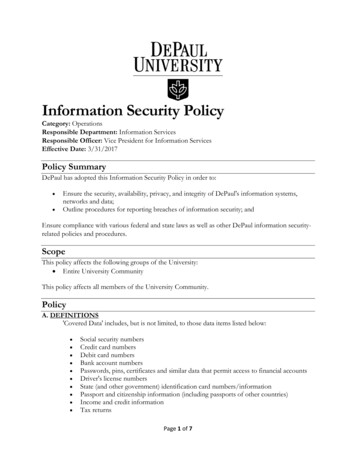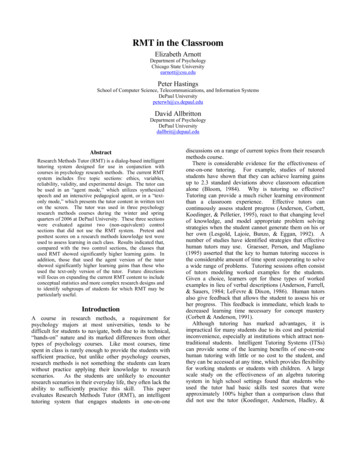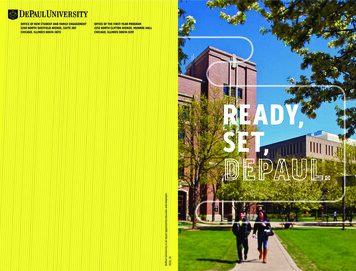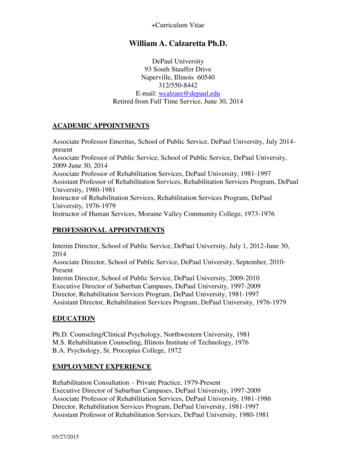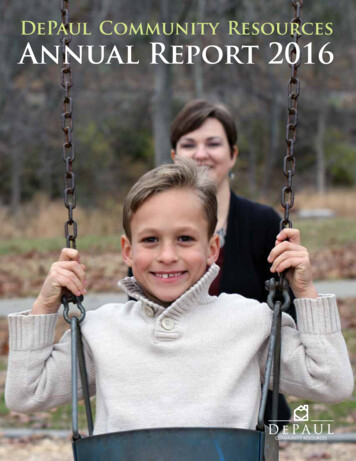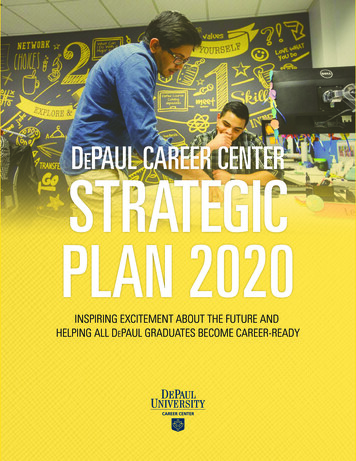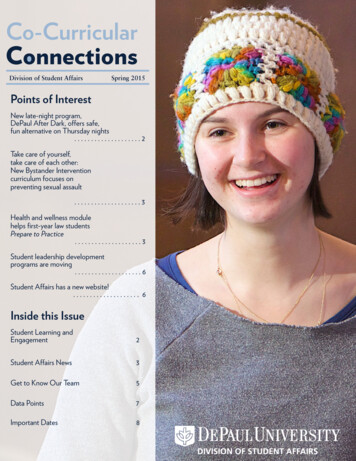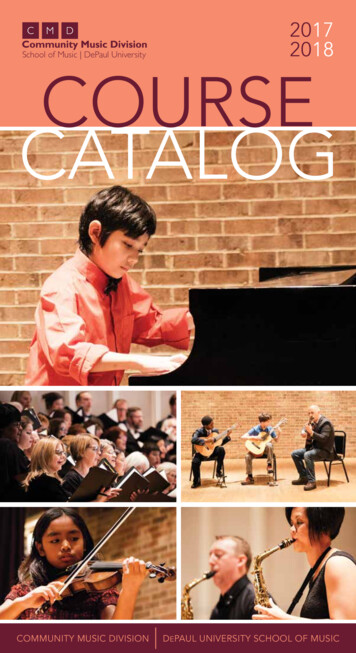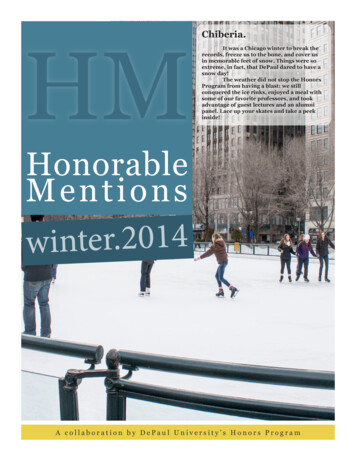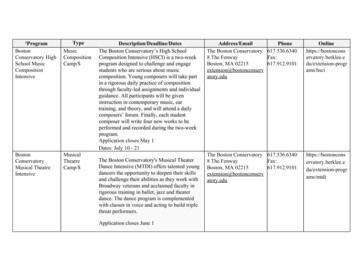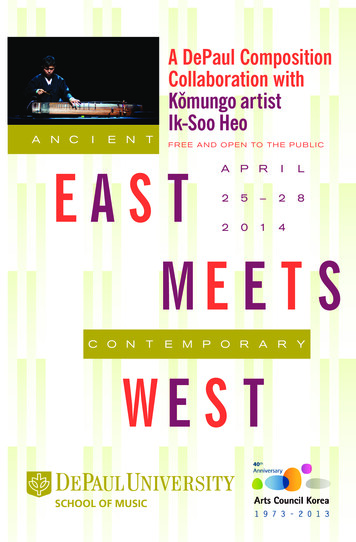
Transcription
A N CIE NTA DePaul CompositionCollaboration withKǒmungo artistIk-Soo HeoF ree an d open to t h e p u b licEASTME E T SC O NTAP RIL25–282014E M P O R A R YWE S T
A n c i e n t Ea s t M e e ts C o n t e m p o r a ry W e s tA p r i l 25 –28 , 2014Dear friends,The composition department of the School of Musicwelcomes you to this special series of concertscelebrating the interaction of cultures as a way ofcreating new musical works.Faculty member Dr. Seung-Ah Oh proposed thisproject as a means of connecting DePaul and Koreankŏmungo virtuoso, Ik-Soo Heo. Over the past sixmonths, composers at DePaul, faculty, undergraduateand graduate students alike, have been getting to know this six-string bass zither (aninstrument few knew existed) by way of videos, Skype, lecture demonstrations, andexperiments with our own practice instrument, generously loaned to us by Ik-Soo Heo.The entire composition department has worked together and apart to compose worksthat make use of recent musical vocabularies for an instrument that dates from aboutthe fourth century, the kŏmungo, found originally in the kingdom of Goguryeo, thenorthernmost of the Three Kingdoms of Korea.We are grateful to Ensemble 20 and its conductor Michael Lewanski for joining usin this endeavor. This remarkable student ensemble enlivens the DePaul new musicscene each academic year with six annual concerts of significant, provocative worksof new music that enrich the musical lives of performers and composers, and help tocreate a nurturing environment at DePaul for new creations.We are also grateful to the DePaul administration, including Dean Donald Casey,Associate Dean Judy Bundra, and Julie DeRoche, chair of the performance department,for their support of this endeavor, Ensemble 20 and the composition program.We hope you enjoy the products of our creative interactions and we also hope it ispossible to present similar concert events in the years to come.Regards,Kurt WesterbergChair, Department of Musical Studies
F r iday, Apr il 25 8 : 00pm D e Paul C onc e r t HallSatur day, Apr il 26 7: 00pm D e Paul R ec ital HallNew Music DePaulwith Ensemble 20 and Ik-Soo Heo, kǒmungoTraditional Korean Music featuring Ik-Soo Heo, kǒmungoCabinet of CuriositiesIk-Soo Heo, kŏmungoKendy Johnson, violaMorgan Little, celloAndrew Pederson, double bassDie Entfremdung für solo KŏmungoIk-Soo Heo, kŏmungoWinterborneIk-Soo Heo, kŏmungoJessica Sun, violin IHenry Zheng, violin IISamuel Pederson, violaQuinn Klarer, celloSara Neilson, double bassIssac Stevenson, percussionChristopher Wendell Jones(b. 1969)NamKuk Kim(b. 1971)Kurt Westerberg(b. 1950)Christopher Wendell Jones, conductorKǒmungo Recital of Student CompositionsWorks byWilliam Berthouex (b. 1990)Owen Davis (b. 1989)T. Duncan Parker (b. 1990)Christopher Wood (b. 1991)Zach Moore (b. 1992)Kasia Szczech (b. 1995)Stephen Boi (b. 1991)John Telfer (b. 1998)Ik-Soo Heo, kŏmungoSeung-Ah OhJulia Bentley, mezzo sopranoIk-Soo Heo, kŏmungoIssac Stevenson, accordionOwen Davis, percussion IRobert Diaz, percussion IIJustin Sterchele, percussion IIIAlexander Ellsworth, celloZachary Moore, double bassIk-Soo Heo, kŏmungoSuk-Jong Lee, jangguMonday, Apr il 28 7: 00pm D e Paul R ec ital HallMichael Lewanski, conductorChoHeeGin-SanJo in Shin Quae Dong style(b. 1969)
D e Pau l U n i v e rs i t y Sc h o o l o f M us i cA n c i e n t E a s t M e e ts C o n t e mp o r a ry W e s t Ap r i l 25 –28 , 2014F r iday, Apr il 25 8 : 00pm D e Paul C onc e r t HallNew Music DePaulwith Ensemble 20 and Ik-Soo Heo, kǒmungoCabinet of CuriositiesIk-Soo Heo, kŏmungoKendy Johnson, violaMorgan Little, celloAndrew Pederson, double bassChristopher Wendell Jones(b. 1969)Cabinet of Curiosities is a curated microcosm of sounds native to two cultures.The trio of low Western string instruments, viola, cello and bass, act as a collectivebody that frames the Korean kŏmungo. Initially, melodies played by the kŏmungoare scattered among soft, blank, noisy fields of sound, highlighting the distinctivelyvocal qualities of the kŏmungo. As the balance between these elements shift, withthe melodic fragments becoming progressively longer and the noise elementsbecoming progressively shorter, the low trio joins the kŏmungo, finding its voice andadopting a vocabulary influenced by the indigenous sound of this instrument.Die Entfremdung für solo KŏmungoIk-Soo Heo, kŏmungoNamKuk Kim(b. 1971)In Die Entfremdung, Kim tries to express and depict the psychology of alienationand estrangement of the family members of Gregor Samsa during his transformationinto a large monstrous insect in Kafka’s Die Verwandlung (The Metamorphosis).The psychology of anger and transcendence is transmitted by the contrast of timbresbetween the Bartók pizzicato technique on DaeHyun (string I) and the harmonics onthe open string GyeHahChung (string V).WinterborneIk-Soo Heo, kŏmungoJessica Sun, violin IHenry Zheng, violin IISamuel Pederson, violaQuinn Klarer, celloSara Neilson, double bassIssac Stevenson, percussionMichael Lewanski, conductorKurt Westerberg(b. 1950)A winterbourne is a stream that remains dry through the summer months beforebecoming active in the rainy seasons of late fall through early spring (bourne is theAnglo-Saxon word for stream). Winterbournes are usually found in areas with chalkysoil bordering clay valleys, such as the Salisbury plain in England. I first encounteredthe term in a novel by Edward Rutherford: “It had been dry all summer but whenthe November rains began to fall upon the high ground, then the waters would descend,sometimes a steady stream, sometimes a deluge.” The imagery of summer drynessleading to moisture in winter was very appealing to me (especially while living throughthe winter of 2014) and related well to the sounds I was already trying to work with inthis composition. From the beginning, I was trying to use the kŏmungo as an integralpart of a string/percussion ensemble – the instrument is given an independent part, but apart that initiates or adds on to, sometimes completing the sonic material performed bythe ensemble. The work begins with all instruments producing brittle, percussive soundsthat eventually lead to pitched sounds which increase in activity before fading away.Two of the lower strings of the kŏmungo are detuned – the lowest B-flat is tuned as aB, and the fourth string is tuned as a C.Seung-Ah OhChoHeeJulia Bentley, mezzo sopranoIk-Soo Heo, kŏmungoIssac Stevenson, accordionOwen Davis, percussion IRobert Diaz, percussion IIJustin Sterchele, percussion IIIAlexander Ellsworth, celloZachary Moore, double bass(b. 1969)Christopher Wendell Jones, conductorChoHee is a nearly twenty-minute adaptation of two excerpts of a music theaterpiece called Words and Beyond II: Hun NanSulHun (ChoHee) which I have beenworking on since 2013. The original production was written for a jungga singer(Korean traditional vocal technique), kŏmungo, accordion, three percussionists,and two dancers. In creating a concert-oriented ensemble setting, I have replacedthe jungga singer with a mezzo-soprano and added cello and double bass. The firstmovement depicts ChoHee’s speechless and disoriented soul returning to the presentand confronting a tomb. Her soul sings with a sound that has no meaning. I haveextracted the vowels from the poem utilized in the next movement, Premonition.In Premonition, ChoHee predicts her own death at the age of twenty-seven withthe analogy of lotus falling three times nine under a cold winter moonlit night. Ifelt conflicted about whether or not the composition should emulate the emotion ofactual falling to describe her death or the complete opposite. The final result focuseson her eternal freedom from her past life as a prisoner in a failing marriage and asocial outsider rather than the excruciating loneliness of her short life.
D e Pau l U n i v e rs i t y Sc h o o l o f M us i cA n c i e n t E a s t M e e ts C o n t e mp o r a ry W e s t Ap r i l 25 –28 , 2014As for the protagonist, ChoHee received her name from her birth family. In the16th century, unless they had been born into the upper class, women were not given“valuable” names. Therefore, ChoHee invented a name for herself, Nan-Sul-Hun,meaning orchid-snow-house.Words and Beyond II: Huh NanSulHun (CHoHee) starts with a scene recallingChoHee’s soul arriving at the present moment. She looks at her own tomb, facing twoother tombs bearing the bodies of two children—her own children. She cannot clearlyremember her past at the beginning of the scene. However, while encountering objectssuch as tombs, a lotus, carp in a pond, her own poems, calligraphy, and paintings andwitnessing rituals such as burning the book containing her poems and specific dances,she starts to remember her short but intense twenty-seven-year life. She also starts toremember that the more than four hundred poems she composed for herself were meantto communicate with her own inner being. She remembers the entrapment of herself inher own flesh and becomes aware of her spirit freed from any ties during her lifetime.She finally identifies the name that she invented for herself, NanSulHun (蘭雪軒), theletters of each meaning orchid, snow and house respectively: the symbolism of being inclear touch with and making peace with herself.After her death, her diplomat brother took over four hundred poems that she had writtento China, which received enormous attention and achieved instant success. Koreare-imported her poems much later. To this day, her poems remain some of the mostvaluable Korean literature. All of her poems are in Chinese and in a haiku-like style.Here is the poem used in the second movement, Premonition. I will not dare attempt anEnglish translation of the poem; however, I give the meaning of each Chinese characterto make some sense for the second half of the essential part of the �海鸞朶寒해 (Korean)란타한Byawk Heh Chyim Yoh Heh (Transliteration in English)Chong Lahn Oowey Cheh LahnBoo Yong Sahm Goo TahHong Tah Whahl Sahng HanBoo-Yong (Lotus/Hibiscus mutabilis) Sahm (Three) Goo (Nine) Tah (to hang downor slacken)Hong (Red) Tah (to Fall) Whahl (Moon) Sahng (Frost) Han (Cold)The following is the background information of the music theater that offers a betterunderstanding of the root of ChoHee: Words and Beyond II: Huh Nan Sul Hun isthe second installment of a three-part multi-disciplinary music theater project. Theproduction combines western and non-western musical ideas with dance.The first installment of Words and Beyond: Hwang Jin-Yi is my personalinterpretation of the life journey of early 16th century kiseng (courtesan) HwangJin-Yi. Her journey is sketched out through four selected biographical poems. Herpoems delicately depict her grappling with various inner and social struggles.Huh Nan-Sul-Hun (ChoHee) is another exceptional woman from the late 16thcentury. She also had inner conflicts and agonies resulting from her social status andsocietal norms; however, Hwang Jin-Yi and Huh Nan Sul Hun arose from opposingsocial classes. Hwang Jin-Yi was a lower class woman born of an aristocrat andkiseng and Huh Nan Sul Hun was an aristocrat and the daughter of a minister.Satur day, Apr il 26 7: 00pm D e Paul R ec ital HallTraditional Korean Music featuring Ik-Soo Heo, kǒmungoGin-SanJo in Shin Quae Dong styleIk-Soo Heo, kŏmungoSuk-Jong Lee, jangguSanjo is a style of instrumental solo music, performed in the Sinawi style to the originalKorean rhythm, jangdan. It consists of several continuous movements that start at anextremely slow tempo and increase to an extremely fast tempo over a period of an hour,without a break. The man who developed the kŏmungo sanjo, Baek Nak Jun, was only20 years old in 1896 when he played kŏmungo sanjo for the first time.When Baek Nak Jun composed kŏmungo sanjo, Korea was a hierarchical society. Atthe time, kŏmungo was considered the best musical instrument and was the musicalinstrument of choice for the Yangban class (the artistocrats). Baek Nak Jun, beingfrom a lower class, was most familiar with pansori, the genre of the “commonpeople,” and brought pansori and kŏmungo together, which angered members of theYangban class so much, that they tried to have him killed.In addition, in the early days of kŏmungo sanjo, it was overshadowed by the musicalgenre, Jeongak (court music) which was enjoyed by the upper class. Howeverkŏmungo sanjo’s musical value gradually started to be recognized.Baek Nak Jun had three important students: Kim Jong Gi (金宗基), Park Seok Gi(朴錫驥), and Shin Quae Dong (申快童). Each of these three students then had alineage of kŏmungo sanjo. The music you hear today is a Shin Quae Dong stylekŏmungo sanjo. Shin Quae Dong extended this Sanjo on the basis of Baek Nak Jun’soriginal melody.
D e Pau l U n i v e rs i t y Sc h o o l o f M us i cA n c i e n t E a s t M e e ts C o n t e mp o r a ry W e s t Ap r i l 25 –28 , 2014In 1967, South Korea’s Cultural Heritage Administration designated this Shin QuaeDong style kŏmungo sanjo as No. 16 of National Important Intangible Cultural Property.He attended Gukak National High School and entered the College of Music ofSeoul National University, receiving his master’s degree and doctorate. While inschool, Heo immersed himself in learning traditional music in the most reliableof curriculums. Not only that, as he played for his own creative music recitals(approved as a kŏmungo recital by National Gukak Center in 2009 and creativemusic recitals by Seoul Foundation for Arts and Culture in 2011 and 2012), Heoproposed a new way for the field of kŏmungo to take to insure a brighter future ofthe instrument.Running time 50 minutesMonday, Apr il 28 7: 00pm D e Paul R ec ital HallKǒmungo Recital of Student CompositionsWorks byWilliam Berthouex (b. 1990)Owen Davis (b. 1989)T. Duncan Parker (b. 1990)Christopher Wood (b. 1991)Zach Moore (b. 1992)Kasia Szczech (b. 1995)Stephen Boi (b. 1991)John Telfer (b. 1998)In 1999, his ability and talent were acknowledged as he won the first prize in thegeneral category at the Dong-a Music Competition and in 2006, Heo received thegrand prize in the category of the masters at Okbogo-Kŏmungo Competition. In2013, he won the presidential prize at Nangye-Korean Music Competition.He wrote about melodies of Yin-sik Jang’s Yeongsanhoeisang, an instrumental pieceof refined music, for his master’s thesis while he reconstructed Nak-jun Baek’s sanjo,accompanied on kŏmungo in his doctoral dissertation at Seoul National University.He entered Gyeonggi Provincial Traditional Music Orchestra in 2002 and is nowa senior player. Heo is also doing his best with growing promising instrumentalplayers at music schools of Seoul National University and The University of Suwon.Ik-Soo Heo, kŏmungoSuk-Jong Lee, percussion, is a graduate of the Seoul Centre for ImportantIntangible Cultural Property No. 25 and is a Senior Member of Gyeonggi ProvincialTraditional Music Orchestra.BiographiesKŏmungo player, Ik-soo Heo, has focused hiscareer on collaborating with contemporarycomposers to create pieces for the kŏmungo,a six-stringed Korean traditional zither. Thesecollaborations give audiences the opportunityto take a new look at the traditional Koreaninstrument. By combining the flexibilityof traditional music with the systematicstructures of Western music, Heo is findingnew possibilities of kŏmungo both withcomposers in Korea and around the world.Rather than simply accept Western music,Heo makes sure that he plays particularpieces which help him discover musicalinheritances, which kŏmungo should have,from new perspectives.Kurt Westerberg received degrees from St. OlafCollege and Northwestern University, studyingwith G. Winston Cassler, Arthur Campbell andAlan Stout. He joined the faculty of DePaulUniversity (Chicago, Illinois) in 1987 and iscurrently an Associate Professor as well as chairof the Department of Musical Studies. Westerberghas composed over 100 works for solo keyboard,solo voice, chamber ensembles, choral ensembles,electronics, wind ensembles, and orchestralensembles which have been performed nationallyand internationally in a variety of venues. Recentworks performed include: Einstein DreamPreludes (2007) for solo piano, Night Music II(2009) for two pianos, Rituals and Laments (2009)for solo percussionist, Nomads for flute, clarinetand cello (2011), Vision and Prayer (2012) for solovoices and chamber ensemble, Ensembles and Monologues for Clarinet Trio (2014)
D e Pau l U n i v e rs i t y Sc h o o l o f M us i cand several works for solo piano (2001 – 2014). Winter Light for orchestra, PianoTrio, Fantasy for violin and piano, and Concerto for Wind Ensemble were recordedand released on a Southport CD entitled Uncertain Light in 2010. Vision and Prayerwas just released on a Southport CD entitled Dual Visions. Westerberg is also anexperienced pianist, organist and conductor and has been Director of Music at St.Paul’s Lutheran Church in Evanston since January, 1998.Christopher Jones is a composer of intricatelydesigned music that explores issues of identity,memory and time in distinctive, unconventionalways. Christopher has presented his musicin performances and lectures nationally andinternationally at venues including the DarmstadtFerienkurse in Germany, the Ictus InternationalComposition Seminar in Brussels, PontificiaUniversidad Javeriana in Bogotá, Colombia, MerkinHall in New York and the Milwaukee Art Museum.He has worked with a broad range of ensembles andsoloists such as the St. Lawrence String Quartet,the Callithumpian Consort, the sfSoundGroup,guitarist, Magnus Andersson, violinists, Janet Sungand Mark Menzies, pianist, Ann Yi and flautist, LisaCella. Among his honors are commissions fromthe Koussevitzky Foundation, three commissions from the American ComposersForum, and a Cohn Fellowship to attend the Djerassi Resident Artists Program inWoodside, CA.Also an active pianist and conductor, Christopher has a strong affinity forexperimental and avant-garde music. He has given numerous premieres and hasworked with composers such as Sylvano Bussotti, John Cage, Julio Estrada, HelmutLachenmann, and Stefano Scodanibbio. He merges his interests in composition,performance and improvisation as a member of the innovative Bay Area new musicgroup, sfSound.Currently residing in Chicago, Christopher joined the music faculty at DePaulUniversity as Assistant Professor of Musicianship and Composition in 2011. As along-time resident of San Francisco, he previously taught composition and musictheory at Stanford, San Francisco State, and San José State Universities, and workedextensively with young composers at Lowell High School in San Francisco througha Composer-in-the-Schools residency sponsored by the American ComposersForum. He completed a doctorate in composition at Stanford University, studyingprincipally with Brian Ferneyhough and Jonathan Harvey. He also earned degrees incomposition from the University of Calgary, and piano from Indiana University andthe New England Conservatory.A n c i e n t E a s t M e e ts C o n t e mp o r a ry W e s t Ap r i l 25 –28 , 2014A native of Korea, NamKuk Kim received international attention at the 41stDarmstadt International Music Festival in 2002 as the first Asian to win theComposers Award with his composition Kranichsteiner. After studying at KyungHee University and Chung-Ang University in Korea, he moved to Frankfurt,Germany to study with Hans Zender. The deep appreciation for and connectionto his Korean heritage became embedded in his composition and started showinghis future path more clearly once his studies began in Germany. In 2005, Kim’sversatility on Ajaeng (the one and only bowed string instrument in Koreantraditional music) boosted his teacher’s aspiration of non-western music. Theircollaboration led to Zender’s opera Chief Joseph being premiered at the BerlinerStaatsoper (Berlin State Opera), where Kim’s Ajaeng part played an important role.Since returning to Korea, he has received numerous notable commissions from theSeoul Arts Foundation and the 51st Venice Biennale among others. He currentlyteaches at KyungHee and Chung-Ang University in Seoul, Korea.Seung-Ah Oh, a native of Korea, is an acclaimedcomposer who was described as “a name toremember” in the Dutch newspaper Volkskrant(2005 Sep). Her music has been performedthroughout Europe, North America and Asia, andtranscends traditional boundaries. As critic MirjamZegers writes, “Oh connects East and West, vibrantmotion and stillness, pure sound and ritual theatre,stratified structures and transparency.”The recipient of fellowships from the GuggenheimFoundation, the Rockefeller Foundation atthe Bellagio Center, the Goddard LiebersonFoundation through the American Academy ofArts and Letters, and the Barlow endowmentfor music composition, Oh is celebrated both inher home country and abroad: at the 3rd SeoulInternational Competition for Composers she received both first prize and theaudience prize; in 2007 the third prize of the Lutoslawski Award in Poland; in2010 an international jury awarded her the Toonzetters Prize, given yearly for thebest contemporary music composed in the Netherlands.Oh’s background is as varied as her accolades. She began her studies at Korea’sChuGae Art School and Ewha Women’s University. She went on to earn herPhD in the United States, at Brandeis University, before her studies led her to theNetherlands and the Royal Conservatory of The Hague. Until then, her music hadbeen rooted in the contemporary Western tradition. It was during her time in theNetherlands that she began to explore the rich musical traditions of her own heritage.
D e Pau l U n i v e rs i t y Sc h o o l o f M us i cA n c i e n t E a s t M e e ts C o n t e mp o r a ry W e s t Ap r i l 25 –28 , 2014Her music was described as “ exciting in which you can experience a greatvariety of timbre and organic development”, “refined sharply cut” (Volkskrant,NL) and “brought Asian sensitivity and meditation” (Plain Dealer, Cleveland, US).Michael has guest-conducted musicians from the Chicago Symphony Orchestra,the International Contemporary Ensemble (ICE), the Chicago Chamber Musicians,the Fifth House Ensemble, the Prometheus Chamber Orchestra, and the AnaphoraEnsemble. He has led over 100 world premieres. He is the conducting assistantat the Civic Orchestra of Chicago. Michael’s recordings include works by KurtWesterberg, Franco Donatoni, Aaron Einbond, Kyong-Mee Choi, and JaniceMisurell-Mitchell. He has acted as producer of albums by saxophonist Ryan Muncyand Third Coast Percussion.Oh’s recent work juxtaposes soloists or groups of instruments against an ensemble,creating a space for dramatic development. The conflict between the individual’swill and the collective’s demands is a frequent theme.She has received scholarships, fellowships and grants including the MetLifeCreative Connections program by Meet The Composer, the residencies at the YaddoCoporation and MacDowell Colony, Tanglewood Music Center, Norfolk MusicFestival, the Schumann-Ford scholarship, the Munzer fellowship, and stipend fromFond Podiumkunsten, and various commissions from De Fonds voor de ScheppendeToonkunst/Nederlandse, the Amsterdam Fonds and invitations from festivals such asHuddersfield Contemporary Music Festival (UK), Music of Our Age ContemporaryMusic Festival (Hungary), Gaudeamus International Music Week (Netherlands),November Music Festival (NL), Transit Fetival (Belgium), Alicante ContemporaryMusic Festival (Spain), Ultima Oslo Contemporary Music Festival (Norway),Nedelandse Muziek Dagen (NL), Aspen Music Festival (US), Tanglewood MusicFestival (US). Her music was heard through VPRO (Dutch National Television &Radio), Radio 4, Concertzender in the Netherlands and NHK FM in Japan.Since 2005, Oh has taught at Brandeis University, Massachusetts Institute ofTechnology, the University of Florida at Gainesville and the Oberlin Conservatoryof Music. In fall 2011, she joined the faculty of DePaul University as AssistantProfessor of Composition.Michael Lewanski was appointed AssistantProfessor of Instrumental Ensembles at the DePaulUniversity School of Music in 2012 after havingserved as an adjunct professor since 2007; he enjoysa varied career as a champion of contemporarymusic and standard repertoire alike. He is theconductor of the DePaul Chamber Orchestra,Ensemble 20 (20th and 21st century music), coconductor of the DePaul Wind Ensemble, andfrequent guest conductor of the DePaul SymphonyOrchestra. In addition to his work at DePaul,Michael is conductor of the internationallyacclaimed Chicago-based Ensemble Dal Niente. Heattended the 2012 Darmstadt International SummerCourses for New Music where Ensemble Dal Niente,under his direction, became the first ensemble to beawarded the prestigious Kranichstein Music Prize.A native of Savannah, Georgia, he made his conducting debut at age 13 withthe Savannah Symphony Orchestra. At 16, he was the youngest student everaccepted into the conducting class of the legendary Ilya Musin at the St. PetersburgConservatory in Russia. Michael attended Yale University, where his studiesincluded conducting with Lawrence Leighton Smith and piano with Sara Laimon.He was music director of the Yale Bach Society Orchestra and conductor of theYale College Opera Company. His post-Yale education featured conducting studywith Cliff Colnot, focusing on rehearsal techniques and preparation of all kinds ofensembles. He has also studied with Lucas Vis.In addition to the 2012 Darmstadt Summer Courses, recent festival appearancesinclude the 2010 and 2012 Chicago Youth in Music Festival, the 2010 UnboundFestival of American Chamber Music, the 2011 Unruly Music Festival, the 2012and 2013 International Beethoven Festivals, the 2013 Ecstatic Music Festival,and the 2013 MusicArte festival in Panama. Michael has held an appointmentas conductor of the Columbia College Chicago-sponsored Columbia CommunitySymphony Orchestra. He has been an assistant conductor of the Northwest IndianaSymphony Orchestra. He was formerly music director of the Skokie Concert Choir.He has collaborated with stage director Paul Koch on a number of nontraditionalproductions of Baroque opera. As a pianist and harpsichordist, he has appearedthroughout the Chicago area accompanying singers and instrumentalists. Michaelis also an active writer, chamber music coach, arranger, and conducting teacher. Asan educator of pre-collegiate students, he has worked with the Chicago Academy forthe Arts and the Elgin Youth Symphony.Michael’s schedule in the 2013-2014 concert season includes concerts with fourDePaul School of Music Ensembles, a full season of contemporary music withEnsemble Dal Niente (including appearances at the Bowling Green New MusicFestival and Harvard’s Fromm Concerts), guest conducting Chicago SymphonyOrchestra chamber ensembles, recording projects, and continued work with theCivic Orchestra of Chicago.
The composition department of the School of Music welcomes you to this special series of concerts celebrating the interaction of cultures as a way of creating new musical works. Faculty member Dr. Seung-Ah Oh proposed this project as a means of connecting DePaul and Korean kŏmungo virtuoso, Ik-Soo Heo. Over the past six
